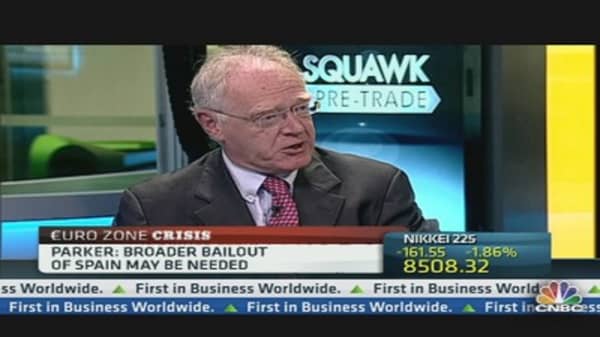Worries that Spain, the euro zone’s fourth-largest economy, will become the latest casualty to need a direct full-blown rescue from its neighbors drove investors out of the country’s debt on Friday and sent yields to euro-era highs.
But one hedge fund manager says it could pay to be contrarian now and go long on Spanish bonds.
Anthony Scaramucci, Managing Partner of SkyBridge Capital, told CNBC that he is putting more money into Spanish paper, even as most fund managers are shunning the asset class, because the returns are too attractive to turn down.
“You got to understand that U.S. Treasurys are at 1.6, 1.7 (percent), or pick a number on a given day, you’re getting 5 times the risk-free rate of return for a sovereign which does have taxing power and does hold hostage the northern European countries,” Scaramucci told CNBC Asia’s “Squawk Box”on Monday.
He does not advise clients to put all their money into Spanish debt but says that it is a “very interesting play” over the longer term because he believed that it is a matter of time before the euro zone nations agreed to combine their debt and underwrite risks across the region.
“(I’m) Making a bet now, and digging in a little bit if yields get higher, with the understanding that over a 3-year period of time, we are going to look back and say, oh my god, they actually unified Europe from a fiscal integration point of view.”
The yield on 10-year Spanish bonds climbed to a euro-era high of 7.317 percent on Friday, after Spanish newspapers reported that regional governments may need to apply for financial help from the central government, reinforcing worries it is a matter of time before Spain ran out of funds. The rubber-stamping on Friday of a rescue package for Spain's troubled banking sector agreed in June also did little to allay concerns.
In fact, shorter-duration bonds are also under pressure, signaling that markets are already pricing in a “full-blown bailout for Spain, similar to the ones for Greece, Portugal and Ireland”, and, said John Noonan, Senior FX Analyst at Thomson Reuters in Sydney.
Five-year Spanish yields hit a euro-era high of 6.928 percent, up 46 basis points on the day, while two-year yields spiked 62 basis points to 5.86 percent.
“Everyone is focusing on the 10-Year, but the yield curve is flattening so you are seeing that the areas where Spain has to borrow in or does their borrowing in, the yields there are going through the roof so, yeah, they are pretty much frozen out of the markets and the market is pricing in something bigger,” Noonan said.
However, Like Scaramucci, Noonan believes that Europe will eventually pool its debt and agree to underwrite each other’s credit risk as a region because Spain, along with Italy, is “too big to fail,” he said.
“At the end of the day what they’re going to have to do is have common eurobonds, they’re going to have fiscal consolidation of the euro group,” Noonan said. “And, that means Germany and Holland and Finland, as much as they don’t want to, they’re going to be forced to come to the party.”
The International Monetary Fund has advocated the issuance of short-term euro bills as a band-aid to runaway sovereign debt costs. For instance, bonds worth roughly 15 percent of the zone's gross domestic product, for example, could help pave the way for euro and go some way to help bring down borrowing costs.
But while nations such as France support the proposal, Germany has staunchly opposed the idea, with German Chancellor Angela Merkel repeatedly saying that E.U. requires shared fiscal and financial union before euro bonds can be seriously considered.
Scaramucci is optimistic that fiscal union will happen sooner or later, as opposed to market observers who advocate a break-up of the euro zone.
“I do believe that mutualization will win out,” Scaramucci said. “If you look at the outcomes of a fractured Europe, it is almost impossible for these governments to sustain that.”
— By CNBC’s Jean Chua.




